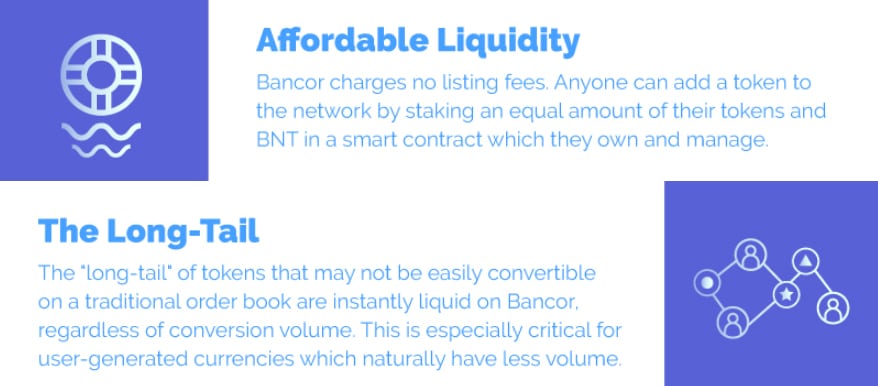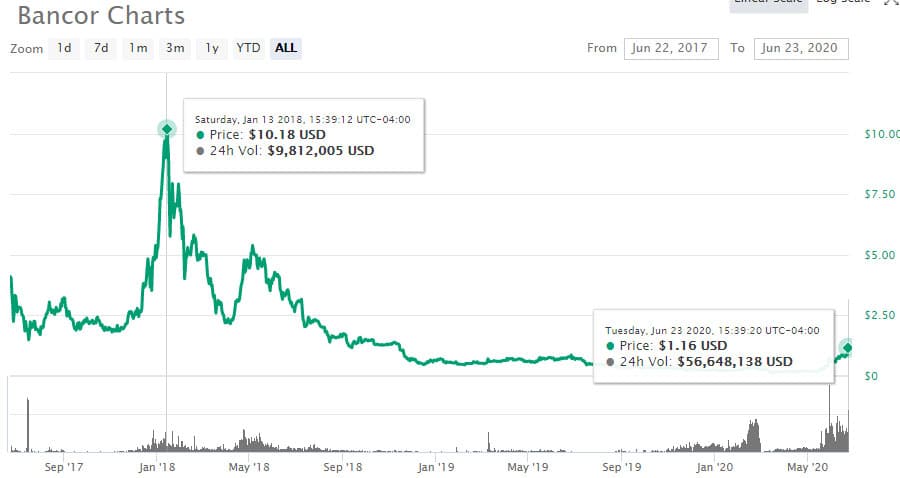While there are plenty of blockchain projects focused on dApps and the conversion of tokens, one that stands out is the Bancor Network and its BNT token.
Indeed, this project is one of the most well known in the cryptocurrency space. It has also had its fair share of ups and downs. From a blockbuster ICO to legal challenges. From widespread partnerships to a widely publicized hack.
However, is it something you should consider?
In this Bancor Network Token review, I will give you everything that you need to know. I will also take a look at the long term prospects and adoption potential of BNT.
What is the Bancor Network?
The Bancor Network has created an elegant solution in its decentralized network which allows traders to swap ERC-20 ad EOS tokens seamlessly across nearly 10,000 token pairs, and all with a single click.
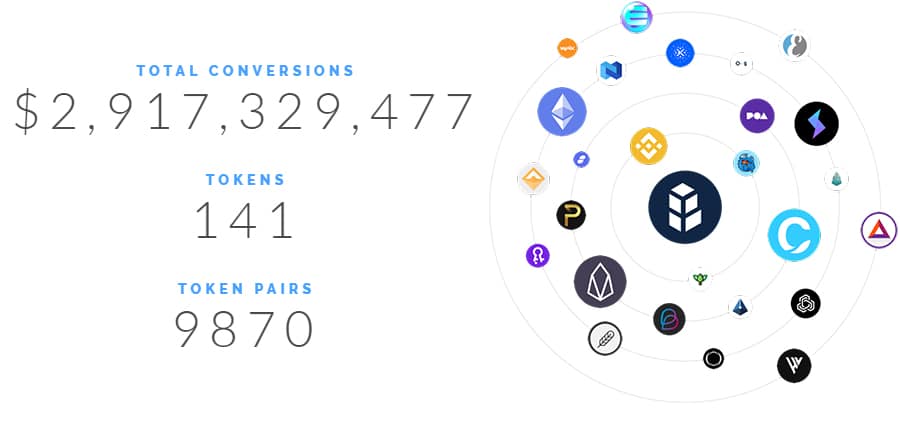
Image via Bancor Website
Bancor allows users to instantly convert between two tokens without needing a counterparty to the trade. This is all done right within the Bancor wallet, and this model has allowed Bancor to provide traders with automatic liquidity for trades.
More importantly, it allows the network to remain completely decentralized, and much of the functionality of the network is thanks to the innovative use of the BNT token to facilitate trades.
So, this all sounds really intriguing but in order to understand the real heft behind Bancor, we have to go over its relatively eventful history.
Bancor Network Background
The Bancor Network is overseen by the Bancor Foundation, which is based in Zug, Switzerland. The company also operates a Research & Development center in Tel Aviv, Israel, which gives the company a foothold in the rising blockchain hub in Zug as well as the rising Middle Eastern technology center of Tel Aviv.
The company was founded in 2016 by a group is Israelis with a background in Silicon Valley start-ups, as well as experience in scaling startups and blockchain technologies. It was named after the international trade balancing currency initially envisioned by John Maynard Keynes.
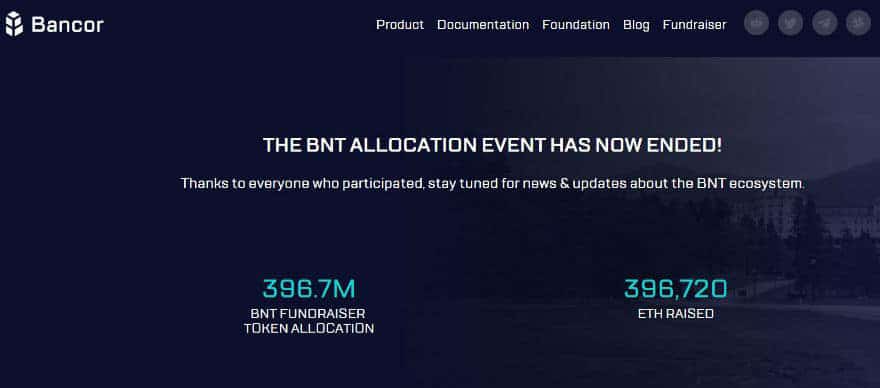
Token Sale Page for the Bancor Network Token
The Bancor Network is perhaps most well-known for holding one of the most successful ICOs ever. In 2017 it set a world record by raising over $153 million in Ethereum tokens in less than 3 hours. The world-record has since been topped by several projects (including SIRIN Labs and Tezos), but remains an impressive beginning for the project.
Since the ICO the Bancor Network has seen over $1.5 billion in token conversions take place on its platform, all facilitated by the BNT token. In addition, there are over 100 liquidity providers serving as Bancor nodes, and these nodes provide over $13 million in liquidity by staking BNT tokens to power token conversions.
More recently, on January 1, 2020 Bancor has added dramatically to its liquidity pool by airdropping all of its Ethereum Reserve, which totaled 10% of the BNT marketcap at the time, in the form of ETHBNT Bancor Pool Tokens.
In effect this added 60,000 liquidity providers, although it’s understood that many of the airdrop recipients simply turned around and sold the tokens. Still, the Bancor network has gone from liquidity of just under $4 million on January 1, 2020 to over $17 million as of mid-June 2020.
Cross-chain Conversion
Bancor has made the user experience of exchanging tokens quite easily. The intuitive wallet app is slick and allows for the quick and easy conversion of tokens similar to what users get when using Coinbase Pro or other custodial wallets.
While the user interface makes it look simple, behind the scenes the Bancor wallet is transacting directly with BNT smart contracts on the blockchain, all while allowing users to retain full control of their private keys and funds at all times.
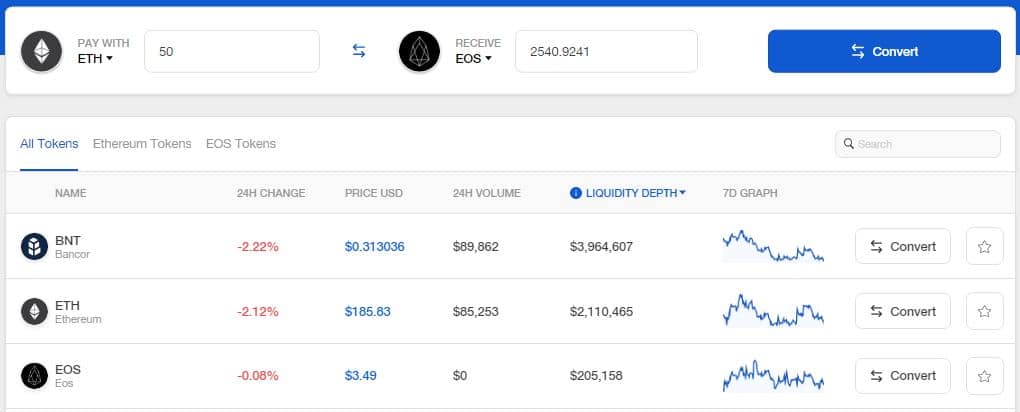
Cross Chain Token Swap on Bancor
The obvious advantage of Bancor’s wallet is that it not only allows for the exchange of tokens, but it does so without the need for a counterparty. This makes it the first network to allow cross-chain conversions without requiring users to give up their private keys in the process of the exchange.
Bancor began their cross-chain integration efforts with EOS and Ethereum, however, they have plans to add other bridges over time, eventually enabling them to function as a multi-chain liquidity solution that can provide instant token conversions for many of the popular blockchains such as Bitcoin, Tron, and Ripple.
Range of Conversions
Already Bancor gives traders and investors an amazing range of conversion options, with fee-less, instant trades available for Ethereum and EOS tokens across more than 8,700 token pairs right through the Bancor wallet.
To make a comparison, one of the most popular exchanges Binance has roughly 196 tokens available, but just 586 trading pairs.
Automatic Liquidity
One of the greatest benefits of Bancor and the BNT token is that they bring liquidity to cryptocurrency markets, and without liquidity, currencies are apt to wither and die. After all, who wants to own a currency that can’t be easily bought and sold.
Of course, the top cryptocurrencies like Ethereum, Ripple, Litecoin, and others in the top 20 have enough trading volume on their own, but the Bancor Protocol brings a unique solution that delivers automatic decentralized liquidity to any token.
Through the Bancor Protocol any token at all, even those privately created, can get instant liquidity, no matter what size trade volume the token enjoys. This is incredibly important functionality when it comes to facilitating the adoption of decentralized applications.
Since many dApps have their own tokens, and now those tokens are able to be converted with other cryptocurrencies instantly and with a single click right within a user’s wallet.
How Bancor Protocol Works
At this point, you might be wondering if it’s really necessary to have another decentralized exchange. After all, the centralized exchanges seem far more popular at this point, and there are dozens of active exchanges already providing a trading platform and liquidity for cryptocurrencies.
In short, yes the world does need another exchange, or at least it needs an exchange like Bancor. That’s because the Bancor platform provides a much-needed service of increasing liquidity for any token, and of creating a platform where any token can be exchanged without the need for a counterparty.
This is something that can’t be accomplished with any other asset. Take fiat currencies as an example. If you want to exchange U.S. dollars for Yen you need to find someone willing to sell Yen to complete the transaction. Every asset is like this. There must be a buyer and a seller for a transaction to work.
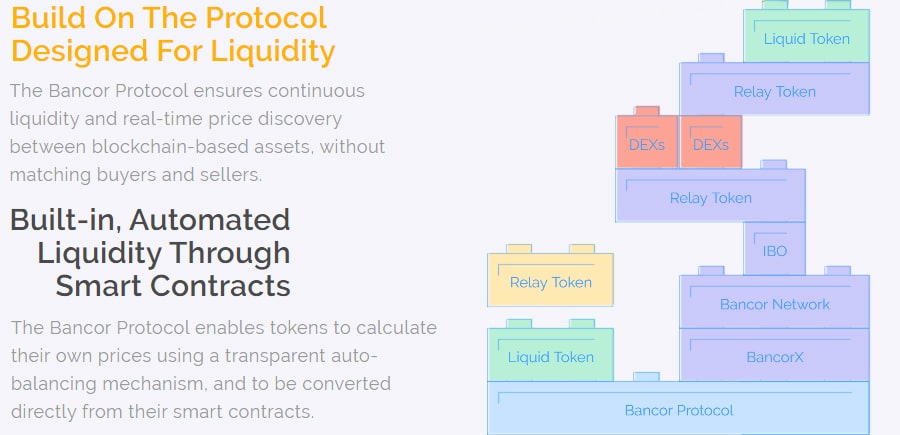
Overview of the Bancor Protocol for external developers
Bancor only requires one person to complete a trade, with the liquidity provided by the native BNT token and its smart contracts. The BNT token’s smart contracts ensure that there is a balance between tokens at all times. Once any trade is concluded there will also be a total remaining that represents the BNT balance coded into the smart contract.
This structure removes the need for the exchange to act as a third-party to transactions. With Bancor and its BNT token, you are able to continually perform exchanges for Ethereum and EOS compatible tokens right through the Bancor wallet.
You can think of the system as an hourglass. It’s a closed system and it doesn’t matter how you turn the hourglass, it always holds the same quantity of sand. In this analogy, the hourglass represents the BNT smart contract, and the grains of sand are the tokens being traded.
And next up from the team will be a development marketplace for dApps that will also make use of the cross-chain compatibility and balanced smart contracts. Also in the pipeline for the future is staking rewards to incentivize liquidity, and a BancorDAO to add self-governance to the blockchain and fully decentralize.
Bancor Staking Rewards
BNT staking rewards are a future enhancement that is planned to incentivize users to provide liquidity for the network. The basis for adding staking is that Bancor needs liquidity to lower fees for traders, while also increasing trading volume and overall network fees. By providing users with an incentive to add liquidity to the network Bancor is expecting to see its network grow and flourish.
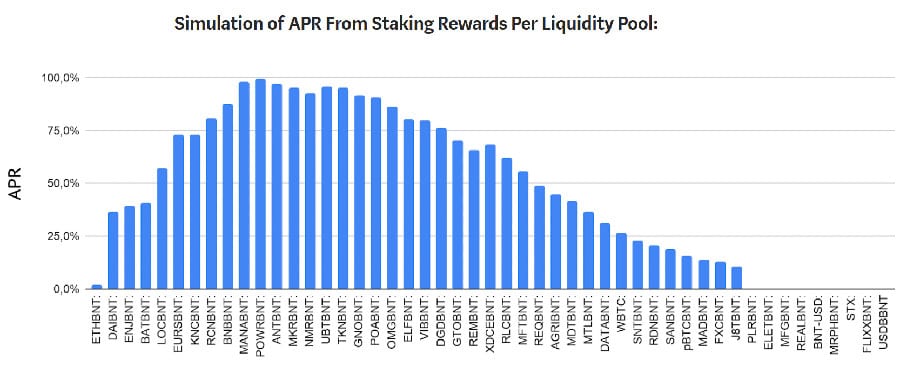
Simulated Staking APRs. Image via Bancor Blog
While plans for adding staking rewards are in the early stages the basics are that users will receive rewards of BNT for holding their BNT in an existing liquidity pool such as MKR/BNT or ETH/BNT. The amount of new BNT that will be created as staking rewards and the distribution of staking rewards to different pools on the network will be decided by users voting in the BancorDAO.
This type of reward system is expected to pull new users into the ecosystem thanks to the APR generated by fees and staking rewards. Bancor is carefully designing their staking rewards system to avoid concentrating the rewards in a small number of pools, choosing instead to provide an even distribution across dozens of network pools.
Bancor Team
The Bancor Network was founded in 2016 by Israeli siblings Guy and Galia Benartzi. Both remain active with the project, with Guy on the Foundation Council, while Galia is in charge of business development. She is also a strong proponent of women in blockchain and crypto.
The Foundation Council president was Bernard Lietaer until his death in February 2019. Since then I have been unable to locate any update that names his successor.

Galia & Guy Benartzi & Yudi Levi. Images via Bancor & Twitter
The CTO of Bancor is Yudi Levi, and he’s held that position since the start of Bancor in 2016. Prior to that, he was co-founder and CTO of AppCoin. He also spent over a decade as a chief architect of several mobile projects, including Real Dice, Mytopia, and Particle Code.
The team also has an impressive list of advisors, including Brock Pierce, the Chairman of the Board at the Bitcoin Foundation, and venture capitalist TimDraper.
The BNT Token
As was mentioned earlier, Bancor held an ICO on June 12, 2017 that raised $153 million in just three hours. That ICO sold roughly 40 million BNT tokens at an average price of $3.92 each. Currently, there’s a circulating supply of BNT of nearly 70 million tokens.
The BNT token hit its all-time high of $10.00 on January 10, 2018 and its all-time low of $0.117415 on March 13, 2020. As of mid-June 2020 it has recovered remarkably from its March all-time low and trades at $1.17 for an amazing gain of 1,500% in three months! That gain was primarily powered by news of the July 2020 release of Bancor V2.
The circulating supply can change however since BNT is created as needed to initiate exchanges. The Bancor protocol will create as much BNT as needed to match the value of currencies held within the smart contract. Once staking rewards are added the circulating supply will necessarily increase more rapidly and regularly.
Trading & Storing BNT
Interestingly, the Bancor Network only handles around 2% of the trading volumes of BNT. The largest trading volumes by far can be found at Coinbene, followed by Bilaxy, Binance, and OKEx, and then comes the Bancor Network. There are a handful of other exchanges that also handle BNT exchanges, but trading volumes are minimal at best.
In fact, Coinbene controlled over half of the total token trading volume for BNT when I checked. This could actually be a problem from a market liquidity perspective. It means that trading is highly dependent on one exchange and any disruption there could cause a collapse volume.
Moreover, if we were to take a look at the order books on an individual exchange such as Binance it is clear that there is a lack of liquidity there. You will need to be very careful when placing an order there as if reasonable sized orders are likely to lead to slippage.
Once you have your BNT tokens you are going to want to store them in a secure offline wallet. Given that these are ERC20 tokens it means that you can store it any Ethereum compatible wallet. There is also a mirror-image EOS based token that was created to mimic the ERC-20 token and to allow exchanges of EOS based tokens.
If you’re trading or staking (once that’s available) then storing BNT in the native Bancor Wallet will make sense.
Bancor V2
Late in April 2020, with the BNT token languishing around the $0.20 level the team announced that they would soon be releasing Bancor V2. The token didn’t immediately respond, but by mid-May it had began a serious rally, and a month later is trading at $1.17. That’s especially amazing given that the token was at its all-time low just a short time before in mid-March 2020.

Bancor V2 Announcement. Image via Bancor Blog
The Bancor Protocol V2 is expected to add several important features that will put Bancor at the front of the pack of decentralized finance projects. The changes are meant to address four key issues commonly cited as obstacles to the widespread adoption of Automated Market Makers (AMMs):
- Exposure to “impermanent loss”
- Exposure to multiple assets
- Capital inefficiency (i.e., high slippage)
- Opportunity cost of providing liquidity
It’s interesting to see that the new features will be opt-in and users are able to create and fund new AMMs with some, all, or none of the new features. Technical details, documentation, and source code has been promised to be released prior to the July launch of Bancor V2.
Development & Roadmap
The Bancor network is an interesting mix of open source and closed source software. Some of the core code is known only by the company whereas there are open source repositories for developers to build on.
Some people argue that the lack of full open source code means that potential vulnerabilities could exist which have not been vetted by the community. Indeed, this may have been the case with the hack we cover below.
Having said that, we can still get a good idea of how much work is being done on the Bancor protocol based on these two repositories.
Below you have the total commits to two smart contract repositories in the Bancor GitHub. These are the total commits over the past 12 months to the repos.
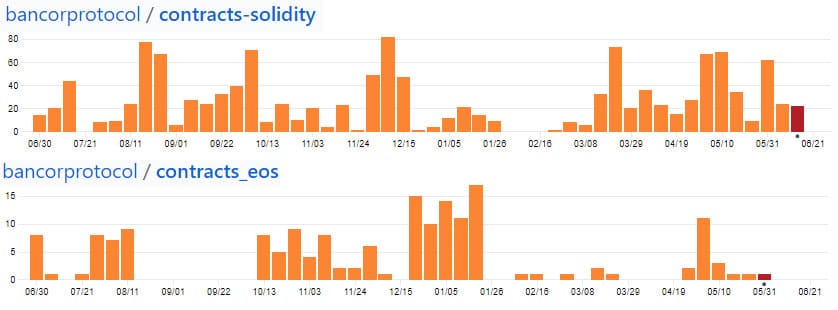
Commits to Select Repos over last year
As you can see, there has been a relatively steady flow of commits that have been pushed to these repos. This shows that the developers are still actively working on the protocol.
Of course, this may exclude all the work that is being done in the private repositories. Indeed, if we were to take a look at the roadmap it would seem as if the project has quite a bit in front of them.
Roadmap
In September of this year, the Bancor team released their updated roadmap for the next 6-12 months. Some of the most important things to look out for include the following:
- Community Staking: This will allow anyone on the Bancor Network to stake their tokens and add to the liquidity of the network. In return for this they will earn a staking reward
- Stable BNT: This will be a stablecoin Bancor Token which will hold its value with USD. This will provide liquidity to the ecosystem while eliminating the risk posed by a fluctuating BNT price.
- BNT Airdrop: Those who hold BNT on Ethereum & EOS can look forward to an airdrop of BNT’s Ethereum reserve
- BNT Inflation: The team hopes to upgrade the BNT token to an inflationary model where the initial inflation level will be set to 0%
- BNT Voting: A governance component will be added. With voting, holders of BNT tokens will be able to take part in decisions that will affect the ecosystem
The team has not released defined milestones for these steps but they have managed to execute on previously defined goals. This includes the BancorX launch on the EOS MainNet and the EOS / ETH cross chain experience.
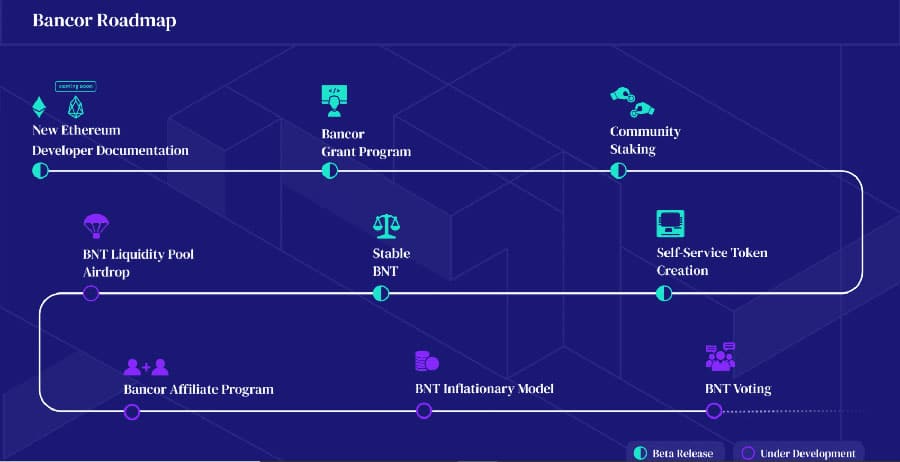
Bancor Roadmap
As of June 2020 the only goals from this roadmap that have been achieved are the BNT Airdrop and the stable BNT token, which is the USDB. We can only presume the other goals will be achieved after Bancor V2 is released, supposedly in July 2020.
If you wanted to keep up to date with developments on the Bancor protocol then you can read follow their official blog or their Twitter account.
Conclusion
One of the major roadblocks in mass adoption is the lack of liquidity, and difficulty in exchanging various tokens for each other. The Bancor Protocol has done away with this problem through the automation of liquidity.
It’s true that complete beginners will face a small learning curve, but the UI of the wallet is as simple as they come. Anyone new to cryptocurrencies should have no problem learning how to make exchanges using the Bancor wallet.
Moreover, the Bancor Protocol is making it easier for developers to build a seamless exchange application between a plethora of tokens. There are also a host of updates that have been planned for the next 6 to 12 months.
Of course, there are still questions linger around the project including the issues of regulations in the U.S. and beyond. Potential centralisation of control in the three year transition period may deter some who fear the potential for arbitrary frozen accounts.
You also have the really paltry token performance of BNT especially over the past year. Yes, it is true that many other tokens are in a rut but BNT appears to have been hit particularly hard. Perhaps this was all in relation to the legal challenges?
Either way, Bancor does have some great technology, use cases and a strong team powering it forward. Those ICO funds are likely to help them weather the storm and further refine their offering.
Featured Image via Shutterstock
Disclaimer: These are the writer’s opinions and should not be considered investment advice. Readers should do their own research.
Source: https://www.coinbureau.com/review/bancor-network-token-bnt/
- &
- 000
- 100
- 2016
- 2019
- 2020
- active
- Ad
- Adoption
- ADvantage
- advice
- advisors
- airdrop
- All
- Allowing
- announced
- Announcement
- app
- Application
- applications
- April
- APT
- around
- asset
- Automated
- Automation
- Bancor
- Basics
- behind the scenes
- BEST
- Billion
- binance
- Bit
- Bitcoin
- blockchain
- blockchain projects
- blockchain technologies
- board
- Books
- build
- business
- cases
- Cause
- chairman
- change
- charge
- chief
- closed
- Co-founder
- code
- community
- company
- component
- contract
- contracts
- Conversion
- Council
- Counterparty
- Creating
- crypto
- cryptocurrencies
- cryptocurrency
- CTO
- currencies
- Currency
- curve
- DApps
- data
- decentralized
- Decentralized Applications
- Decentralized Exchange
- Decentralized Finance
- decentralized network
- developers
- Development
- Disruption
- dollars
- Early
- eastern
- ecosystem
- EOS
- ERC-20
- ERC20
- ETH
- ethereum
- exchange
- Exchanges
- Face
- fair
- Features
- Fees
- Fiat
- finance
- First
- flow
- follow
- form
- Forward
- full
- function
- fund
- funds
- future
- GitHub
- good
- governance
- great
- Group
- Grow
- hack
- High
- history
- hold
- How
- How To
- HTTPS
- ICO
- ICOs
- idea
- image
- Including
- Increase
- inflation
- integration
- International
- investment
- Investors
- Israel
- issues
- IT
- July
- Key
- keys
- launch
- lead
- learning
- Legal
- Level
- Liquidity
- liquidity providers
- List
- Long
- major
- Making
- March
- Market
- marketplace
- Markets
- Match
- million
- Mobile
- model
- months
- Most Popular
- names
- network
- New Features
- news
- nodes
- offering
- OKEx
- open
- open source
- Opinions
- Options
- order
- orders
- Other
- partnerships
- People
- performance
- perspective
- platform
- Plenty
- pool
- Pools
- Popular
- power
- president
- price
- private
- Private Keys
- project
- projects
- rally
- range
- readers
- regulations
- research
- returns
- review
- Rewards
- Ripple
- Risk
- sale
- scaling
- seamless
- sell
- sense
- serving
- set
- Share
- Short
- Silicon Valley
- Simple
- Size
- small
- smart
- smart contract
- Smart Contracts
- So
- Software
- sold
- Space
- stablecoin
- stake
- Staking
- start
- Startups
- store
- Storm
- successful
- supply
- switzerland
- system
- Technical
- Technologies
- Technology
- Tel Aviv
- The Basics
- time
- token
- Tokens
- top
- trade
- Traders
- trades
- Trading
- transaction
- Transactions
- TRON
- u.s.
- ui
- Update
- Updates
- UPS
- USD
- users
- value
- venture
- volume
- Voting
- Vulnerabilities
- Wallet
- Wallets
- What is
- WHO
- within
- Women
- Work
- world
- year
- Yen
- Zug


